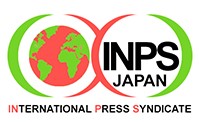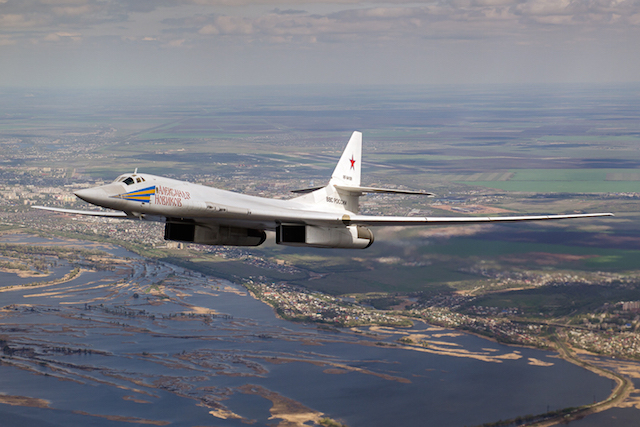By Ramesh Jaura
BERLIN (IDN) – Major nuclear disarmament groups are deeply concerned over speculations whether a Russian Tupolev Tu-160 supersonic bomber, intercepted late September in British airspace, was planning to attack the country and unleash World War 3. They have urged Russian President Vladimir Putin and U.S. President Barack Obama to agree to “an immediate reduction in nuclear risks”.
In a letter addressed also to Congressional Committees, Ministers for Defence and Foreign Affairs as well as other policy makers, the nuke disarmament groups warn of “the risks of catastrophic unintended consequences arising from possible clashes between NATO and Russian forces during a number of recent exercises”.
The letter made public on October 7 points out that in September, a Russian Tupolev Tu–160, a strategic bomber and a missile carrier that was intercepted by NATO (North Atlantic Treaty Organization) forces during an incursion into the British airspace, was discovered to have started the countdown to arm a nuclear bomb.
Human Survival Project (HSP) and People for Nuclear Disarmament (PND) – both based in Australia – coordinated the letter. HSP was “adopted” by the Council of the Centre for Peace and Conflict Studies (CPACS) at Sydney University in June 2012 as a joint initiative of CPACS and PND. The latter has been active in Australia since 1960 and has a significant presence in the international disarmament movement.
HSP and PND say that both Russian and NATO forces have recently conducted a number of exercises that were ‘mirror-imaged’ by the other side in close proximity to each other. “Nuclear-armed forces on both sides may have been involved. The potential for catastrophic miscalculation is obvious,” they say.
The letter initiated by HSP and PND, supported by several nuclear disarmament organizations is one of a series of communications that have been written over the last few months on this issue, including one by Generals Cartwright and Vladimir Dvorkin, responsible for the operation respectively of the U.S. and Russian nuclear forces.
Signatories of the letter include: the International Physicians for the Prevention of Nuclear War (IPPNW), awardee of 1985 Nobel Peace Prize; Mayors for Peace 2020 Vision Campaign, comprising cities from around the world; the Middle Powers Initiative, the World Future Council – WFC; and the Nuclear Age Peace Foundation. Several members of various parliaments have signed the letter.
The letter points to “apocalyptic” stakes. The use of the U.S. and Russian nuclear arsenals, constituting some 90-95 percent of total global nuclear stocks, would completely destroy all that we now call ‘civilisation’ in less than 90 minutes, nuclear disarmament groups say.
“The burning of large numbers of cities, itself encompassing the deaths of up to half of all humans,(depending on targeting) would give rise to catastrophic global climatic consequences, affecting even countries that had no involvement in the initial conflict, and resulting in temperatures colder than the last ice-age,” warns the letter.
It adds: “This would mean that most of those still left would either starve or freeze in the darkness of a nuclear winter.”
Three nuke risk reduction measures
Nuclear risk reduction measures that disarmament groups are urging, include: (1) lowering nuclear alert levels so that decision-makers are no longer faced with the necessity to take utterly apocalyptic decisions in time frames measured in a few short minutes based on inadequate information; (2) the sharing of launch data; and (3) the avoidance of provocative military exercises and postures.
In order to stress point 1, the letter draws attention to a number of UN General Assembly resolutions urging a lowering in operational readiness, such as the resolution on ‘Operational Readiness of Nuclear Weapon Systems’ sponsored by New Zealand, Switzerland, Sweden, Chile, Malaysia and Nigeria, and India’s ‘Reducing Nuclear Dangers’ resolution.
As regards point 2, the letter recalls U.S.-Russian agreement in 1998 to establish a Joint Data Exchange Center. It followed a ‘near miss’ in 1995, when a weather research rocket was mistaken for a U.S. SLBM (submarine-launched ballistic missile). That agreement has been reaffirmed a number of times, most recently in 2010. But the Joint Data Exchange Center has yet to be set up.
Referring to point 3, the letter says: “A series of measures concerning nuclear posture, notably ‘no first use’ doctrines and a decision to no longer target cities (as noted above cities are the most prolific source of the black smoke that brings about nuclear winter) would also make a vast contribution to the reduction of the risk of nuclear catastrophe.”
Addressing the Russian and U.S. Presidents, the disarmament groups “strongly echo and endorse” the concern – “if not alarm” – expressed by Generals James Cartwright and Vladimir Dvorkin, former commanders of American and Russian missile forces, from International Physicians for the Prevention of Nuclear War (IPPNW), and from faith leaders worldwide, at the possibility that tension between Russia and NATO may spiral out of control with a catastrophic outcome.
De-alerting nukes
In fact a related study on “de-alerting” (increasing the time gap between order to launch nuclear weapons and actually launching these) by Global Zero headed by Generals Cartwright and Dvorkin says: “Tension between Russia and the West over the Ukraine crisis has brought the parties one step closer to the precipice of nuclear brinksmanship, the point at which nuclear risk skyrockets,” and “it has flared to the point that it is producing dangerous misunderstandings and action-reaction cycles with strong escalatory updrafts.”
The signatories of the letter take note of the fact that on the 40th anniversary – on September 16 – of the signing of the Helsinki Document establishing the Organisation for Security and Cooperation in Europe, the OSCE Parliamentary Assembly adopted a resolution which “Expressed deep concern at increased nuclear threats arising from the deteriorating relationship between Russia and NATO”, and “Called on all OSCE States with nuclear weapons or under extended nuclear deterrence relationships to reduce the risks of a nuclear war by taking nuclear weapons off high-alert, and by adopting no-first use policies”.
Like the OSCE Parliamentary Assembly, signatories of the letter are deeply alarmed over the direction in which the confrontation over the borders of the Ukraine may be going.
“What is placed at risk, in the very worst case, is civilization itself, and potentially, human survival. This is not of course to say that a completely ‘apocalyptic’ event sequence is what WILL take place, or even that this is the most likely outcome of such a sequence.”
The signatories “hope and pray” that nothing of the sort takes place and that a peaceful negotiated settlement of issues arising from the 2014 Ukraine crisis will be eventually reached by all parties, including Russia.
However, in their view, the likelihood of a catastrophic outcome is by no means zero. “The record of history – especially of August1914 – shows that even where national leaders are confident that they have everything in hand, events can spin out of control with consequences that are completely out of proportion to anything that might initially have been at stake.”
The letter continues: “Confrontational attitudes and actions, (particularly between militaries), no matter who initiates them or who is to ‘blame’, can as the European Leadership Network points out, all too easily lead to accidental conflict or even to just plain catastrophic accident.
“If this were to lead to deeper and prolonged military conflict between two parties (such as in the Baltics) there is no telling where it would stop, or if it could be stopped at all without spiraling (as in 1914) into a conflict that no-one actually sought, but which no-one did enough to prevent.”
The safest nuclear weapon by far is one that does not exist at all. The majority of the worlds governments and parliaments, not to mention NGOs, see the elimination of nuclear weapons not as something it might be ‘nice’ to do ‘in some century’, but as an urgent existential priority.
The nuclear disarmament groups, therefore, urge the nuclear weapons states to move toward “the complete and total elimination of nuclear weapons, as mandated by the Nuclear Nonproliferation treaty (NPT) itself, as an urgent existential priority”. [IDN-InDepthNews – 07 October 2015]
Photo: Tupolev Tu-160 | Credit: Wikimedia Commons – Alex Beltyukov


